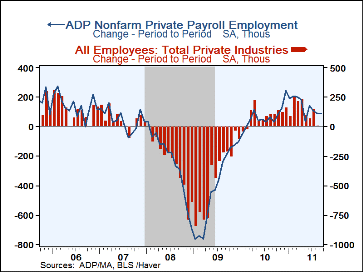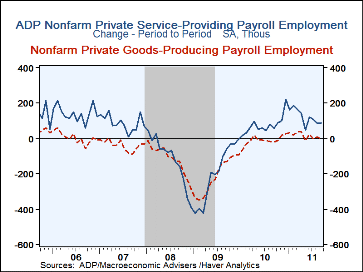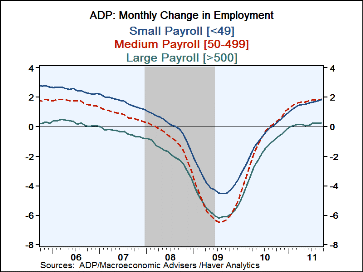 Global| Oct 05 2011
Global| Oct 05 2011ADP Reports That Job Gains Remain Lethargic
by:Tom Moeller
|in:Economy in Brief
Summary
According to the payroll processor Automatic Data Processing (ADP) and economic consultants Macroeconomic Advisers, private nonfarm payrolls grew 91,000 following an 89,000 increase during August, revised from 91,000. The latest beat [...]
 According to the
payroll processor Automatic Data Processing (ADP) and economic
consultants Macroeconomic Advisers, private nonfarm payrolls grew
91,000 following an 89,000 increase during August, revised from
91,000. The latest beat Consensus expectations for a 45,000 rise. The
recent small monthly increases left the three-month growth rate at
1.1% (AR), down from February's 2.4%.
According to the
payroll processor Automatic Data Processing (ADP) and economic
consultants Macroeconomic Advisers, private nonfarm payrolls grew
91,000 following an 89,000 increase during August, revised from
91,000. The latest beat Consensus expectations for a 45,000 rise. The
recent small monthly increases left the three-month growth rate at
1.1% (AR), down from February's 2.4%.
The U.S. Bureau of Labor Statistics will report September payroll employment this Friday. Economists expect a 56,000 worker increase in jobs. By comparison, the August increase of 89,000 in ADP's measure of private nonfarm payrolls was accompanied by a 17,000 rise in the BLS measure of private sector jobs. According to ADP and Macro-Advisers, the correlation between the monthly percentage change in the ADP estimate and that in the BLS data is 0.90. ADP compiles the estimate from its database of individual companies' payroll information. Macroeconomic Advisers, LLC, the St. Louis economic consulting firm, developed the methodology for transforming the raw data into an economic indicator.
A 90,000 increase in service-producing payrolls led the gain in the latest ADP estimate. Goods-producing payrolls rose all of 1,000. Factory sector jobs slipped 5,000. Overall, small-sized payrolls grew 60,000 m/m (1.8% y/y) while medium-sized payrolls rose 36,000 (1.9% y/y). Large payrolls slipped 5,000 (0.3% y/y). Construction employment rose 2,000 and the number of financial activities jobs again was unchanged.
The ADP National Employment Report data is maintained in Haver's USECON database; historical figures date back to December 2000. The figures in this report cover only private sector jobs and exclude employment in the public sector. The ADP methodology is explained here. The expectations figures are available in Haver's AS1REPNAdatabase.
How Economic News Moves Markets is a new study by the Federal Reserve Bank of New York and it can be found here.
| ADP National Employment Report | Sep | Aug | Jul | Y/Y | 2010 | 2009 | 2008 |
|---|---|---|---|---|---|---|---|
| Nonfarm Private Payroll Employment (m/m Chg., 000s) | 91 | 89 | 107 | 1.6% | -1.1% | -4.8% | -0.6% |
| Small Payroll (1-49) | 60 | 58 | 56 | 1.8 | -0.8 | -3.9 | 0.0 |
| Medium Payroll (50-499) | 36 | 31 | 43 | 1.9 | -1.0 | -5.6 | -0.9 |
| Large Payroll (>500) | -5 | 0 | 8 | 0.3 | -2.0 | -5.6 | -1.9 |
| Goods Producing | 1 | 9 | -1 | 1.0 | -5.1 | -12.3 | -3.6 |
| Manufacturing | -5 | -7 | 1 | 1.3 | -3.3 | -11.3 | -3.2 |
| Service Producing | 90 | 83 | 108 | 1.7 | -0.2 | -3.1 | 0.1 |
Tom Moeller
AuthorMore in Author Profile »Prior to joining Haver Analytics in 2000, Mr. Moeller worked as the Economist at Chancellor Capital Management from 1985 to 1999. There, he developed comprehensive economic forecasts and interpreted economic data for equity and fixed income portfolio managers. Also at Chancellor, Mr. Moeller worked as an equity analyst and was responsible for researching and rating companies in the economically sensitive automobile and housing industries for investment in Chancellor’s equity portfolio. Prior to joining Chancellor, Mr. Moeller was an Economist at Citibank from 1979 to 1984. He also analyzed pricing behavior in the metals industry for the Council on Wage and Price Stability in Washington, D.C. In 1999, Mr. Moeller received the award for most accurate forecast from the Forecasters' Club of New York. From 1990 to 1992 he was President of the New York Association for Business Economists. Mr. Moeller earned an M.B.A. in Finance from Fordham University, where he graduated in 1987. He holds a Bachelor of Arts in Economics from George Washington University.








